Joseph Aduedem (Sandema-Bilinsa-Punsa)
THE ART OF SHEPHERDING
THE ORIGINS OF CONFLICT WITH FARMERS IN THE CULTURAL CONTEXT OF THE BULSA
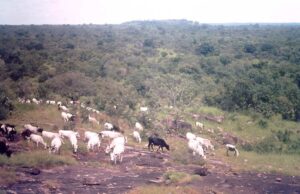
Cows grazing in the bush (photo F.K. 1973)
Introduction
I had that rare privilege of having been a cowboy (Buli: naapierik, plural: naapiesa or naapierisa) continuously for about six years when I was growing up. Thus, for the rainy seasons of 2001 to 2006, I was a full time cowboy and after those years, since it was an art and a hobby in my opinion, I chipped in to take care of the cattle on few occasions again. As such, this presentation is basically sharing personal experiences of what shepherding (Buli: dungsa kasika) entails in the environment of Buluk. Let it be noted that shepherding was a onetime life activity and apart from the regrets of not getting formal education on the part of the lot, everyone who was a cowboy recollects the past with a sense of amusement. Again, this presentation should be read in the context of the Builsa worldview of shepherding so that, while some activities of cowboys might be read in the light of today as vices/bad behaviour, they are considered courageous acts in the sense of a hobby.
Shepherds (naapiesa/naapierisa)
Shepherding (dungsa kasika) starts at the average age of about nine years and it is supposed to stop when the individual is grown up enough to start farming, and so, one can appropriately situate it within the period of adolescence. The main duty of the shepherd (naapierik) is to tend cattle (and in some instances sheep and donkeys). This he does by joining other shepherds and they would have a common assembling point called naakui.
This was where we gathered after opening the cattle-yard in the morning to wait for each other and to separate the calves from their mothers. Then one would be selected among us to take care of the calves while the rest of us with all the cattle went to the bush for them to graze. We would return to the naakui again in the afternoon from the bush, took turns to go home and bring zom (millet flour), and milked the cows (sum naa biisim) afterwards. The naakui was where, apart from the times for grazing, almost all other times of the day were spent.
My Own Activities
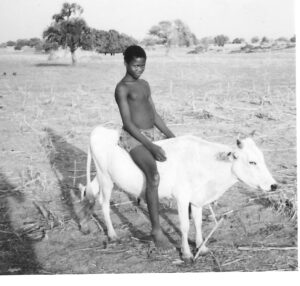
Riding without nose-ring and rope ([cha]boala doka) Photo F.K. 1988
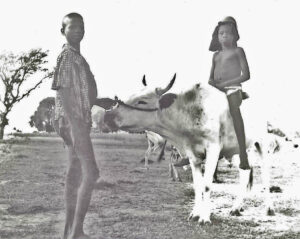
Riding with nose-ring and rope (doka ale ka nyori miik)
As shepherds (naapiesa), there were a number of things we did particularly at the naakui. Apart from the primary duty of sending the cattle for grazing, we had the following activities that were part of the regular life of the shepherd, namely: pieuk takka (pieuk or naabiisim kpaatuk is the thick component of the cow milk when it is allowed to settle for some time), taming of animals for riding (ngan duanta balinka), milking the cows (naabiisim sumka), naming the cows (niiga yue teka), wrestling (jiak) and some other entertaining games like lakoto/lokoto gogka (spinning a snail), bea tongka (owari) and gbang nakka. The last one is a game where sheanuts, partially buried in the sand, are hit against one another to determine whose nut would not be cracked and he became the winner). Usually after milking the cows we ate the naabiisim (cow milk) with the zom (millet flour). However, there was this special skill of drinking the cow milk alone called pieuk takka. For this we would milk the cow milk into our hands, rubbed the palms containing the milk together and as the milk dripped from the palms to the elbows, we licked the whole hand from elbow to the fingers without worrying about hand washing.
Another thing we usually did was taming the wild cattle in order to prepare them for milking (balim niiga magsi sumka) or riding them (balim magsi doka). It should be noted that this demanded a lot of courage and determination from the brave ones among us and every bravery act was always applauded.
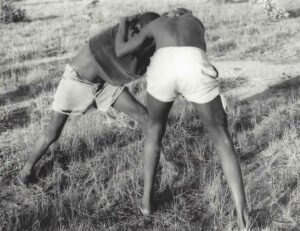
Wrestling: the zuguri style (photo F.K. 1974)
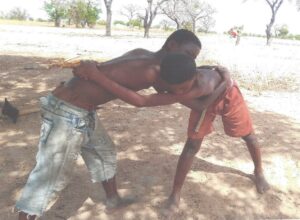
Wrestling: the suka-style (photo J. Aduedem 2020)
One other very characteristic of shepherds meeting at the naakui was wrestling (jiak). There were two kinds of wrestling: the zuguri (head on collision, wrestling like rams) and the suka/asuka (In this style, each wrestler’s right hand goes under the left armpit of the opponent and joins his left hand on the back of the opponent). But the goal of both forms was one, putting the opponent down. There were two reasons that usually called for the wrestling. One was wrestling in order to determine our leader/chief shepherd called the naapien kpagi [cf. Kröger 1987: 272]. After this we determined the ranks of each up to the least rank – the naapien biik. All those below the naapien kpagi are his naapien bisa (pl.). The second reason was if your cow fought another shepherd’s cow, the owners were called to wrestle in order to “clean/fill up the footprints of the cattle” that wrestled (ba si nii-nga nantaata). On few occasions, this wrestling resulted in a real fight, but everything was part of the life of the shepherd.
Conflict with farmers
Farmers have always been the worst enemies of shepherds as far as dungsa kasika is concerned. The truth is, in the cultural context of Buluk, every farmer passed through the art of shepherding (dungsa kasika) and should have had a better understanding and sympathy towards shepherds, but that was not the reality. This unresolvable conflict between shepherds and farmers did not start with our time of dungsa kasika and we did not intend to end it even in our present time. Our enmity had its bases on the following.
First of all, there would usually be some notorious cattle that would stray into the crops of farmers and then you can imagine the destruction it would cause depending on how long it stayed on the farm. This straying away of animals was partly due to our faults out of negligence. Often we would be buried in arguments as to whose turn it was to go and drive the animals back, when we were seriously engaged in swimming or any other activity that was of interest.
Another ground is for letting the animals graze on the farms could simply be out of revenge against a wicked farmer. Thus, it was not uncommon to intentionally drive the cattle into farms of people who had caned us previously just to appease our anger.
The third reason for the enmity between farmers and shepherds stemmed from stealing. Let me say stealing here did not carry with it the negative connotation in the context of shepherding as it will sound in the ears of our today’s society. In fact, it was counted as a brave act and very identical with the task of shepherding. Different items were stolen right from the beginning of the rainy season till the end. When farmers started sowing groundnuts (i.e. around July or August), we went to scoop out the seeds (legsi simkpaam) and ate them. We did not have good reasons for that act because not all followed the cattle with empty stomachs, but as to why we did this, I can only associate it with the mere fact of being a shepherd.
When crops started yielding, that was when we were also ‘yielding,’ for we stole everything from corn (chulembena), groundnuts (sinkpaam), sweet potatoes (naaba nuira), Bambara beans (suma) etc. The groundnuts were eaten as we went about tending the animals but the other items were brought to the naakui and either roasted or boiled. Though as a hobby, anytime we were going for such “operations”, we “fortified” ourselves. We would peel a fibre from the ebony tree (gaab) and tied it around the wrist, and superstitiously it was believed that one would never be caught. Another technique was that even upon the farmer seeing us and we were given a chase by farmers, we ran holding the left hand fisted while reciting the statement Naawen mum kpaara nina yooo (God close the eyes of the farmer) and the belief held was the same, that one would never be caught.
Qualities
From the above, the life of the shepherd could be compared in a loose sense to life in the jungle. Every shepherd therefore needs to exhibit certain qualities to meet the demands of this lifestyle. Some of these include braveness, smartness, ability to run, to disguise and hide, the ability to swim and physical strength. All these are needed for the good of the individual shepherd either in order to rise above the rank of naapien biik, to escape the cane and cruelty of farmers or they are regarded just as hobbies, like swimming.
While the above qualities are necessary, one thing that inspired us with all those daring acts was the belief that shepherds enjoy a special divine providence. This was captured nicely in the words: Naawen ale a nya naa-pierik zuk (God is the one who watches over the shepherd). So one’s justification of being an ideal shepherd was manifested in the exemplary and risky ventures he engaged in. It would therefore be unfair to condemn these acts seen through contemporary eyes.
The contemporary situation of the conflict between shepherds and farmers
Looking back at those years and reflecting upon the tough times we, the farmers and shepherds, gave each other, it gives me the opportunity to see the fight between farmers and the Fulani in Northern Ghana and other parts of the country in a correct perspective. The Fulani as a group are well noted for their nomadic life style and farmers in particular have always had problems with them. Many suggestions and eventually actions against them are often to drive them away. Admittedly, there are a lot of differences between the two groups and their contexts: Our encounters with farmers were not on the same level as the Fulani encounters with farmers. However, looking back at the past from a present point of view, we believe taking violent actions against them might not solve the problem. It would only breed resentment and the desire to pay back.
The only apparent conflict resolution between the Fulani and farmers is the absence of one of the groups in a place. Thus, with the need for schooling and the practice of tying cattle or keeping them under the intensive care system (e.g. in a pen or kraal), the conflict with farmers has reduced drastically.
Biblical evidence of the conflict in the story of Cain and Abel
One thing we need to know is that the conflict had a very long history, dating back to the time of Cain and Abel. When we started studying theology and taking up courses in the Old Testament, something that came up very clear was the etiological orientation of the Pentateuchal narratives. Thus, by etiological stories, the authors used them to explain the meaning or existence of certain events, practices or customs. As such, the story of Cain and Abel is not so much about what is narrated there: jealousy, wickedness or killing, but it is “an explanation on the origin of the two major ways of Israelite life, rearing of cattle and doing agriculture or shepherds and farmers. Abel is described as the first shepherd while Cain is presented as the first farmer” (Kizhakkeyil 2013: 102) and the conflict existed between these two groups.
Again, the choice of Abel’s offering by Yahweh over that of Cain buttresses our belief as shepherds by then that: “Naawen ale a nya naa pierik zuk, God is the one who watches over the shepherd.” After all, is God not noted to always be on the side of the weak? Their attitude and activities as shepherds might have labelled them as “bad boys” but that cannot deny the vulnerability of shepherds. They risk their lives for the sake of the animals that most often were not even their own.
Conclusion
As we come to the conclusion of this paper, the humble appeal once again is that the experiences shared must be seen in a particular context and within a particular tribal setting. So, we should be mindful of how we interpret this outside the context of shepherding in Buluk. In fact I used “the art of shepherding” throughout because it was actually an art, we enjoyed every bit of it within its own worldview.
Secondly, shepherding was the first ‘boarding school’ for every Builsa youth. Thus, the hardships one went through: the wrestling, the exposure to rains and thunder storms, the caning by farmers, the piercing of thorns because of the bare footing, the walking in the thick forest alone in search of a lost cow, and so on and so forth, were preparatory grounds for the shepherds in order to be able to withstand the challenges of adulthood. It is not surprising therefore that many adult Builsa are noted for braveness and strength. To be a shepherd means to prepare the individual for any task in life. Having had the privilege of both formal education and shepherding, I can look at those times only with amazement and hope others, too, would do the same.
References
Kizhakkeyil, Sebastian (2013), The Pentateuch, an Exegetical Commentary, Mumbai: St Pauls.
Kröger, Franz (1987) ‘Traditionelle und schulische Erziehung bei den Bulsa in Nordghana’, Zeitschrift für Ethnologie, vol. 112, 2, pp. 269-283 [English translation].
Kröger, Franz (1992), Buli―English Dictionary. Münster: Lit Verlag.
Photos: J. Aduedem (colour picture); all other photos: F. Kröger
- Editorial
- Various Authors and Sources: Events
- Franz Kröger: Who on Earth Is Interested in the Bulsa? The Bulsa Internet Websites 2018-2020
- The 2019 Feok Festival – a Trilogy
- THE TITLE AND POSITION OF THE SANDEMNAB – A DISCUSSION
- Francis A. Azognab: Should Christians Attend Traditional Funeral Celebrations?
- Stephen Azundem: Exploring the Jewish Concept of Ritual Cleansing from a Bulsa Perspective
- Joseph Aduedem: The Art of Shepherding – The Origins of Conflict with Farmers in the Cultural Context of the Bulsa
- Joseph Aduedem: Kuub Juka or Ngomsika, the Second Funeral Celebration
- Franz Kröger: The Koma and Bulsa (Builsa) of Northern Ghana
- Franz Kröger: Can a Visual Perception be expressed by Sounds? The Buli Ideophones
- Franz Kröger: Good and Evil in Matter and Living Beings
- Franz Kröger: Roman Provinces and British Colonies — Living Between Two Cultures
- Franz Kröger: Sylvester Ateteng Azantilow 1950-2020 (obituary)
- MAIN FEATURE: CREATIVE BULSA: ARTISTS, POETS AND WRITERS
- Patrick Seidu aka Saala-Biik Soakatoa: My Life and Career
- Franz Kröger: Daniel Bukari, an Amateur Artist
- Eric A. Anadem, a Photographer and Artist
- Ghanatta Ayaric: Hard Road to Travel
- John Agandin: A Trotro Ride from New Town to Accra
- John Agandin: The Kayayei’s Tale
- John Agandin: Korona Vairosiwa Tugurika
- Ghanatta Ayaric: In the Meantime!
- Anbegwon Atuire: Rhythm of the War Dance
- Robert Asekabta: Continue Revolution
- Poems in BULUK 1-13